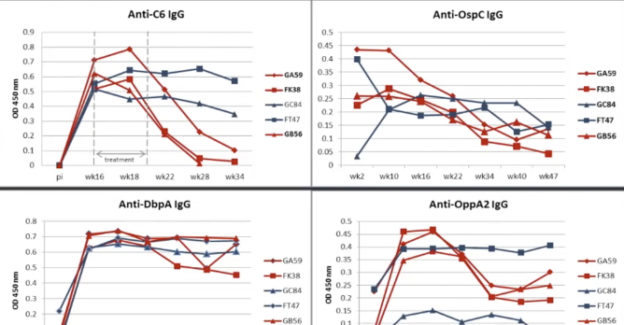Instructor
Monica E. Embers, PhD
Associate Professor in the Division of Immunology
Director of Vector-borne Disease Research
Tulane National Primate Research Center
Description
This module covers a general overview of persistent infection in reservoir and incidental hosts, and immune evasion strategies utilized by the Lyme disease pathogen. Landmark studies on immune suppression by Borrelia are presented. An overview of diagnostic test modalities is discussed, along with recent findings on the variability of antibody responses in humans. Finally, the correlation of treatment success with immune responses is described.
Learning objectives
- To provide a general overview of immune evasion and suppression by the Lyme disease spirochete
- To describe current diagnostic tests and how variable responses to infection affect their accuracy
- To review antibiotic treatment mechanisms and new research showing how immune response may affect treatment outcome
This session, The impact of immune responses on diagnosis and treatment of Lyme disease, is approved for 0.5 enduring AAFP Prescribed credits.
AAFP Prescribed credit is accepted by the American Medical Association as equivalent to AMA PRA Category 1 credit(s)™ toward the AMA Physician’s Recognition Award. When applying for the AMA PRA, Prescribed credit earned must be reported as Prescribed, not as Category 1.
The AAFP has reviewed One Health Medical Education for a Changing Climate and deemed it acceptable for AAFP credit. Term of approval is from 01/02/2024 to 01/01/2025. Physicians should claim only the credit commensurate with the extent of their participation in the activity.
Evidence-based bibliography for further study
Embers, M. E., et al. (2004). “Survival strategies of Borrelia burgdorferi, the etiologic agent of Lyme disease.” Microbes & Infection 6(3): 312-318.
Chung, Y., et al. (2013). “Borrelia burgdorferi elicited-IL-10 suppresses the production of inflammatory mediators, phagocytosis, and expression of co-stimulatory receptors by murine macrophages and/or dendritic cells.” PLoS ONE 8(12): e84980.
Hovius, J. W., et al. (2008). “Salivating for knowledge: potential pharmacological agents in tick saliva.” PLoS Med 5.
Embers, M. E., et al. (2016). “A Five-Antigen Fluorescent Bead-based Assay for Diagnosis of Lyme Disease.” Clinical and Vaccine Immunology.
Embers, M. E., et al. (2017). “Variable manifestations, diverse seroreactivity and post-treatment persistence in non-human primates exposed to Borrelia burgdorferi by tick feeding.” PLoS ONE 12(12): e0189071.
Elsner, R. A., et al. (2015). “Suppression of Long-Lived Humoral Immunity Following Borrelia burgdorferi Infection.” PLoS Pathog 11(7): e1004976.
Aucott, J. N., et al. (2013). “Development of a foundation for a case definition of post-treatment Lyme disease syndrome.” International Journal of Infectious Diseases 17(6): e443-e449.
Blum, L. K., et al. (2018). “Robust B Cell Responses Predict Rapid Resolution of Lyme Disease.” Front Immunol 9: 1634.


